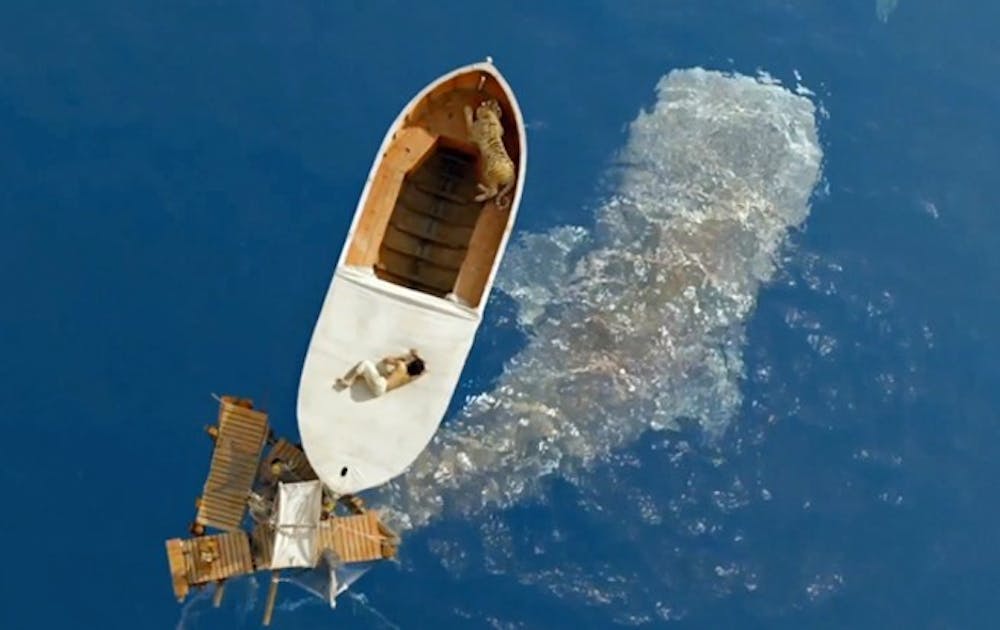Don’t worry, fans of the novel—director Ang Lee did not Shyamalan this movie; the plot is left intact. Lee instead created a visual masterpiece through a faithful adaptation of Life of Pi, a novel long thought to be unadaptable.
He starts by introducing unrecognizable actors in an indistinct suburban home in the frame narrative, immediately highlighting the universal applicability of the story. Slowly he establishes the foreground—Pi (Suraj Sharma) and his family—and background, the flashback narratives that tell of Pi’s upbringing and the shipwreck that left him stranded in the Pacific. Lee spends the perfect amount of time crafting the underlying structure of the plot, devoting only thirty minutes to the period before Pi is stranded on the rescue boat. With him is an eclectic group of strikingly and realistically rendered animals. These animals, especially Richard Parker the tiger, are so lifelike that it is easier to believe they are trained animal actors than to admit they are CGI-produced.
We get fleeting foreshadows of Lee’s cinematic prowess in early scenes— like when he shows the psychedelic imagery of the universe inside young Krishna’s mouth. However, it is only after a hauntingly beautiful scene where Pi is suspended underwater watching his ship sink in silence that Lee’s vibrant filmic tendencies become more evident.
He often uses the reflective properties of water to mirror rosy sunsets or starry skies across the entirety of the screen. Using wide shots, Lee highlights Pi’s isolation. Simultaneously, Lee blends the earth with the heavens, diminishing the importance of the boat and its inhabitants’ struggles while heightening the allegorical connections Pi must recognize. Slowly, the film’s visuals become the focus. What was the foreground becomes the middle ground; the characters lose some significance and become the connections from Pi’s familiar origins to his exotic voyage.
One of Lee’s grandest visual accomplishments is Pi’s projection of what Richard Parker sees as he gazes into the ocean depths, a stunning microcosm of the depth of allegory and plot within the movie. As we delve into the Bengal tiger’s large black eyes, we also delve into the dark Pacific, where images move and change with a fluidity rivaling the water surrounding it. We swim past richly detailed sea life into bright bioluminescence that casts constellations and pointillism portraits across the black canvas of the deep ocean.
The 3D only enhances scenes such as this. Never are there inane, cheap thrills lunging out of the screen. Counter to popular criticisms of the emerging cinematic technology, the picture is not dimmer or dingier than its 2D counterpart. The 3D concretizes dreamlike elements of the film in ways similar to James Cameron’s Avatar. Yet this palpability blends with the film’s reality, making it distinctly superior to Cameron’s dichotomy between the human world and the Na’vi world.
Despite this mastery, there are some imperfections. The first is newcomer Suraj Sharma’s acting; it is somewhat lackluster and amateur despite occupying most of the film’s human screentime. It is never shoddy or detracting, but it is dull in comparison to the dazzling visuals. The second is the music score. With a film centered on images instead of dialogue, it would be expected that the score matches in depth and memorability. Instead, it seems to be a tranquil version of the Slumdog Millionaire soundtrack, its sole purpose to remind us of Pi’s cultural origins.
In the beginning of the film, Pi’s father (Adil Hussain) offers a warning, “Don’t let festival and spectacle fool you—religion is darkness,” while Pi’s uncle describes his tale as a “story that will make you believe in God.” Life of Pi never forgets this thematic dissonance. At the end of the story you will be bewildered by the spectacle and unprepared for the abrupt return to a clinical normality. You probably won’t leave with an entirely new take on religion. Instead, you will ask stimulating questions about the nature of reality and faith. This resonance endows Lee’s adaptation with timelessness.
Get The Chronicle straight to your inbox
Signup for our weekly newsletter. Cancel at any time.

